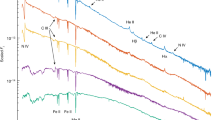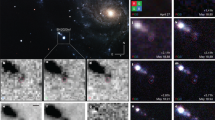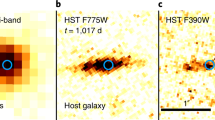Abstract
Hydrogen-poor superluminous supernovae (SLSN-I) are a class of rare and energetic explosions that have been discovered in untargeted transient surveys in the past decade1,2. The progenitor stars and the physical mechanism behind their large radiated energies (about 1051 erg or 1044 J) are both debated, with one class of models primarily requiring a large rotational energy3,4 and the other requiring very massive progenitors that either convert kinetic energy into radiation through interaction with circumstellar material (CSM)5,6,7,8 or engender an explosion caused by pair-instability (loss of photon pressure due to particle–antiparticle production)9,10. Observing the structure of the CSM around SLSN-I offers a powerful test of some scenarios, although direct observations are scarce11,12. Here, we present a series of spectroscopic observations of the SLSN-I iPTF16eh, which reveal both absorption and time- and frequency-variable emission in the Mg ii resonance doublet. We show that these observations are naturally explained as a resonance scattering light echo from a circumstellar shell. Modelling the evolution of the emission, we infer a shell radius of 0.1 pc and velocity of 3,300 km s−1, implying that the shell was ejected three decades before the supernova explosion. These properties match theoretical predictions of shell ejections occurring because of pulsational pair-instability and imply that the progenitor had a helium core mass of about 50–55 M⊙, corresponding to an initial mass of about 115 M⊙.
This is a preview of subscription content, access via your institution
Access options
Access Nature and 54 other Nature Portfolio journals
Get Nature+, our best-value online-access subscription
$29.99 / 30 days
cancel any time
Subscribe to this journal
Receive 12 digital issues and online access to articles
$119.00 per year
only $9.92 per issue
Buy this article
- Purchase on Springer Link
- Instant access to full article PDF
Prices may be subject to local taxes which are calculated during checkout



Similar content being viewed by others
Data availability
The photometry of iPTF16eh is available in Supplementary Table 1, and the spectra are available from WISeREP35 (http://wiserep.weizmann.ac.il/). In general, the data that support the plots within this paper and other findings of this study are available from the corresponding author upon reasonable request.
References
Quimby, R. M. et al. Hydrogen-poor superluminous stellar explosions. Nature 474, 487–489 (2011).
Gal-Yam, A. Luminous supernovae. Science 337, 927 (2012).
Kasen, D. & Bildsten, L. Supernova light curves powered by young magnetars. Astrophys. J. 717, 245–249 (2010).
Woosley, S. E. Bright supernovae from magnetar birth. Astrophys. J. Lett. 719, L204–L207 (2010).
Woosley, S. E., Blinnikov, S. & Heger, A. Pulsational pair instability as an explanation for the most luminous supernovae. Nature 450, 390–392 (2007).
Chevalier, R. A. & Irwin, C. M. Shock breakout in dense mass loss: luminous supernovae. Astrophys. J. Lett. 729, L6 (2011).
Moriya, T. J. et al. Light-curve modelling of superluminous supernova 2006gy: collision between supernova ejecta and a dense circumstellar medium. Mon. Not. R. Astron. Soc. 428, 1020–1035 (2013).
Sorokina, E., Blinnikov, S., Nomoto, K., Quimby, R. & Tolstov, A. Type I superluminous supernovae as explosions inside non-hydrogen circumstellar envelopes. Astrophys. J. 829, 17 (2016).
Gal-Yam, A. et al. Supernova 2007bi as a pair-instability explosion. Nature 462, 624–627 (2009).
Kozyreva, A., Blinnikov, S., Langer, N. & Yoon, S.-C. Observational properties of low-redshift pair instability supernovae. Astron. Astrophys. 565, A70 (2014).
Yan, L. et al. Detection of broad Hα emission lines in the late-time spectra of a hydrogen-poor superluminous supernova. Astrophys. J. 814, 108 (2015).
Yan, L. et al. Hydrogen-poor superluminous supernovae with late-time Hα emission: three events from the Intermediate Palomar Transient Factory. Astrophys. J. 848, 6 (2017).
Law, N. M. et al. The Palomar Transient Factory: system overview, performance, and first results. Publ. Astron. Soc. Pac. 121, 1395–1408 (2009).
Lunnan, R. et al. Hydrogen-poor superluminous supernovae from the Pan-STARRS1 Medium Deep Survey. Astrophys. J. 852, 81 (2018).
De Cia, A. et al. Light curves of hydrogen-poor superluminous supernovae from the Palomar Transient Factory. Astrophys. J. 860, 100 (2018).
Morse, J. A. et al. Hubble Space Telescope proper-motion measurements of the η Carinae nebula. Astrophys. J. Lett. 548, L207–L211 (2001).
Tolstov, A. et al. Pulsational pair-instability model for superluminous supernova PTF12dam: interaction and radioactive decay. Astrophys. J. 835, 266 (2017).
Nicholl, M. et al. Slowly fading super-luminous supernovae that are not pair-instability explosions. Nature 502, 346–349 (2013).
Smith, N. A blast wave from the 1843 eruption of η Carinae. Nature 455, 201–203 (2008).
Pastorello, A. et al. Interacting supernovae and supernova impostors: SN 2009ip, is this the end? Astrophys. J. 767, 1 (2013).
Mauerhan, J. C. et al. The unprecedented 2012 outburst of SN 2009ip: a luminous blue variable star becomes a true supernova. Mon. Not. R. Astron. Soc. 430, 1801–1810 (2013).
Woosley, S. E. Pulsational pair-instability supernovae. Astrophys. J. 836, 244 (2017).
Quimby, R. M. et al. Spectra of hydrogen-poor superluminous supernovae from the Palomar Transient Factory. Astrophys. J. 855, 2 (2018).
Kashikawa, N. et al. FOCAS: the Faint Object Camera and Spectrograph for the Subaru telescope. Publ. Astron. Soc. Japan 54, 819–832 (2002).
Oke, J. B. & Gunn, J. E. An efficient low resolution and moderate resolution spectrograph for the Hale telescope. Publ. Astron. Soc. Pac. 94, 586 (1982).
Oke, J. B. et al. The Keck Low-Resolution Imaging Spectrometer. Publ. Astron. Soc. Pac. 107, 375 (1995).
Masci, F. J. et al. The IPAC image subtraction and discovery pipeline for the Intermediate Palomar Transient Factory. Publ. Astron. Soc. Pac. 129, 014002 (2017).
Cenko, S. B. et al. The automated Palomar 60 inch telescope. Publ. Astron. Soc. Pac. 118, 1396–1406 (2006).
Blagorodnova, N. et al. The SED Machine: a robotic spectrograph for fast transient classification. Preprint at https://arxiv.org/abs/1710.02917 (2017).
Fremling, C. et al. PTF12os and iPTF13bvn. Two stripped-envelope supernovae from low-mass progenitors in NGC 5806. Astron. Astrophys. 593, A68 (2016).
Ahn, C. P. et al. The tenth data release of the Sloan Digital Sky Survey: first spectroscopic data from the SDSS-III Apache Point Observatory Galactic Evolution Experiment. Astrophys. J. Suppl. 211, 17 (2014).
Bertin, E. in Astronomical Data Analysis Software and Systems XV (eds Gabriel, C. et al.) 112 (Conference series no. 351, Astronomical Society of the Pacific, 2006).
Schlafly, E. F. & Finkbeiner, D. P. Measuring reddening with Sloan Digital Sky Survey stellar spectra and recalibrating SFD. Astrophys. J. 737, 103 (2011).
Komatsu, E. et al. Seven-year Wilkinson Microwave Anisotropy Probe (WMAP) observations: cosmological interpretation. Astrophys. J. Suppl. 192, 18 (2011).
Yaron, O. & Gal-Yam, A. WISeREP—an interactive supernova data repository. Publ. Astron. Soc. Pac. 124, 668–681 (2012).
Inserra, C. et al. On the nature of hydrogen-rich superluminous supernovae. Mon. Not. R. Astron. Soc. 475, 1046–1072 (2018).
Vreeswijk, P. M. et al. The hydrogen-poor superluminous supernova iPTF 13ajg and its host galaxy in absorption and emission. Astrophys. J. 797, 24 (2014).
Kangas, T. et al. Gaia16apd—a link between fast and slowly declining type I superluminous supernovae. Mon. Not. R. Astron. Soc. 469, 1246–1258 (2017).
Nicholl, M. et al. On the diversity of superluminous supernovae: ejected mass as the dominant factor. Mon. Not. R. Astron. Soc. 452, 3869–3893 (2015).
Inserra, C. et al. A statistical approach to identify superluminous supernovae and probe their diversity. Astrophys. J. 854, 175 (2018).
Nicholl, M. et al. SN 2015BN: a detailed multi-wavelength view of a nearby superluminous supernova. Astrophys. J. 826, 39 (2016).
Howell, D. A. et al. Two superluminous supernovae from the early Universe discovered by the Supernova Legacy Survey. Astrophys. J. 779, 98 (2013).
Lunnan, R. et al. Hydrogen-poor superluminous supernovae and long-duration gamma-ray bursts have similar host galaxies. Astrophys. J. 787, 138 (2014).
Perley, D. A. et al. Host-galaxy properties of 32 low-redshift superluminous supernovae from the Palomar Transient Factory. Astrophys. J. 830, 13 (2016).
Chen, T.-W. et al. Superluminous supernova progenitors have a half-solar metallicity threshold. Mon. Not. R. Astron. Soc. 470, 3566–3573 (2017).
Chugai, N. N. & Chevalier, R. A. Late emission from the type Ib/c SN 2001em: overtaking the hydrogen envelope. Astrophys. J. 641, 1051–1059 (2006).
Milisavljevic, D. et al. Metamorphosis of SN 2014C: delayed interaction between a hydrogen poor core-collapse supernova and a nearby circumstellar shell. Astrophys. J. 815, 120 (2015).
Margutti, R. et al. Ejection of the massive hydrogen-rich envelope timed with the collapse of the stripped SN 2014C. Astrophys. J. 835, 140 (2017).
Anderson, G. E. et al. The peculiar mass-loss history of SN 2014C as revealed through AMI radio observations. Mon. Not. R. Astron. Soc. 466, 3648–3662 (2017).
Bietenholz, M. F., Kamble, A., Margutti, R., Milisavljevic, D. & Soderberg, A. SN 2014C: VLBI images of a supernova interacting with a circumstellar shell.Mon. Not. R. Astron. Soc. 475, 1756–1764 (2018).
Lundqvist, P. & Fransson, C. The line emission from the circumstellar gas around SN 1987A. Astrophys. J. 464, 924 (1996).
Fransson, C. et al. Narrow ultraviolet emission lines from SN 1987A—evidence for CNO processing in the progenitor. Astrophys. J. 336, 429–441 (1989).
Quataert, E. & Shiode, J. Wave-driven mass loss in the last year of stellar evolution: setting the stage for the most luminous core-collapse supernovae. Mon. Not. R. Astron. Soc. 423, L92–L96 (2012).
Acknowledgements
We are grateful for discussions with C.-I. Björnsson, S. Blinnikov, E. Sorokina, E. Ramirez-Ruiz and J. Fuller. The iPTF project is a scientific collaboration among the California Institute of Technology, Los Alamos National Laboratory, the University of Wisconsin, Milwaukee, the Oskar Klein Centre, the Weizmann Institute of Science, the TANGO Program of the University System of Taiwan, and the Kavli Institute for the Physics and Mathematics of the Universe. This work was supported by the GROWTH project funded by the National Science Foundation (NSF grant no. 1545949). This research was supported by the Swedish Research Council, the Swedish National Space Board, and the Knut and Alice Wallenberg Foundation. Part of this research was carried out at the Jet Propulsion Laboratory, California Institute of Technology, under a contract with the National Aeronautics and Space Administration (NASA). A.G.-Y. is supported by the European Union through ERC grant no. 725161, the Quantum Universe I-Core programme, the Israel Science Foundation, the BSF Transformative programme and a Kimmel award. P.E.N. acknowledges support from the US Department of Energy (DOE) through DE-FOA-0001088, Analytical Modeling for Extreme-Scale Computing Environments. This research used resources of the National Energy Research Scientific Computing Center, a DOE Office of Science User Facility supported by the US DOE under contract no. DE-AC02-05CH11231. IRAF is distributed by the National Optical Astronomy Observatory, which is operated by the Association of Universities for Research in Astronomy under cooperative agreement with the NSF. Some of the data were obtained at the W.M. Keck Observatory, which is operated as a scientific partnership among the California Institute of Technology, the University of California and NASA. The Observatory was made possible by the financial support of the W.M. Keck Foundation. The authors wish to recognize and acknowledge the cultural role and reverence that the summit of Mauna Kea has always had within the indigenous Hawaiian community. We are fortunate to have the opportunity to conduct observations from this mountain.
Author information
Authors and Affiliations
Contributions
R.L. coordinated the observational campaign, was PI of the Keck programme under which the late-time spectra were obtained, analysed the data and wrote the manuscript. C.F. wrote the resonance scattering code, ran the simulations, performed model comparisons, and contributed to manuscript writing. P.M.V. contributed to the interpretation and resonance line calculations and to the manuscript preparation. S.E.W. contributed to the comparison with PPI models and manuscript preparation. G.L., D.A.P., R.M.Q., L.Y., A.D.C. and A.G.-Y. contributed to the discovery, analysis, interpretation and manuscript preparation. M.M.K. contributed to manuscript preparation. S.R.K. is the PI of iPTF and of the P200/Keck programmes under which the early spectra were taken, and contributed to manuscript preparation. A.N. contributed to finding the supernova and to manuscript preparation. N.B., D.O.C. and A.R. reduced spectra. S.B.C. and P.G. obtained and reduced DCT photometry. C.U.F. reduced the P60 photometry. N.S. obtained and reduced the Subaru spectrum. F.J.M. and P.E.N. contributed to the photometric pipelines applied by iPTF. B.D.B. and P.W. contributed to the iPTF machine learning codes for transient search.
Corresponding author
Ethics declarations
Competing interests
The authors declare no competing interests.
Additional information
Publisher’s note: Springer Nature remains neutral with regard to jurisdictional claims in published maps and institutional affiliations.
Supplementary information
Supplementary Information
Supplementary Figures 1–6, Supplementary Tables 1–4
Supplementary Data 1
Machine-readable version of Supplementary Table 1
Supplementary Data 2
Machine-readable version of Supplementary Table 3
Supplementary Data 3
Machine-readable version of Supplementary Table 4
Rights and permissions
About this article
Cite this article
Lunnan, R., Fransson, C., Vreeswijk, P.M. et al. A UV resonance line echo from a shell around a hydrogen-poor superluminous supernova. Nat Astron 2, 887–895 (2018). https://doi.org/10.1038/s41550-018-0568-z
Received:
Accepted:
Published:
Issue Date:
DOI: https://doi.org/10.1038/s41550-018-0568-z
This article is cited by
-
An extremely energetic supernova from a very massive star in a dense medium
Nature Astronomy (2020)
-
Observational properties of extreme supernovae
Nature Astronomy (2019)



